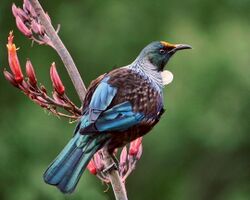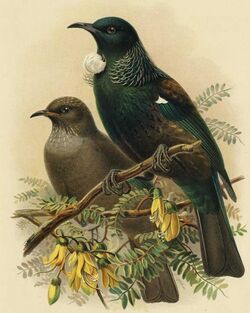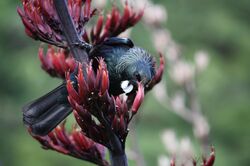Biology:Tui (bird)
| Tūī | |
|---|---|

| |
| Tui on a flax flower stalk, with pollen on its head | |
| Scientific classification | |
| Domain: | Eukaryota |
| Kingdom: | Animalia |
| Phylum: | Chordata |
| Class: | Aves |
| Order: | Passeriformes |
| Family: | Meliphagidae |
| Genus: | Prosthemadera G.R. Gray, 1840 |
| Species: | P. novaeseelandiae
|
| Binomial name | |
| Prosthemadera novaeseelandiae (Gmelin, 1788)
| |
The tūī (Prosthemadera novaeseelandiae) is a boisterous medium-sized bird native to New Zealand. It is blue, green, and bronze colored with a distinctive white throat tuft. It is an endemic passerine bird of New Zealand, and the only species in the genus Prosthemadera. It is one of the largest species in the diverse Australasian honeyeater family Meliphagidae, and one of two living species of that family found in New Zealand, the other being the New Zealand bellbird (Anthornis melanura). The tui has a wide distribution in the archipelago, ranging from the subtropical Kermadec Islands to the sub-Antarctic Auckland Islands, as well as the main islands.
Name
The bird's common name tui comes from the Māori language. The plural is tui in modern English, or ngā tūī in Māori usage;[1] some speakers still use the '-s' suffix to produce the Anglicised form tuis to indicate plurality, but this practice is becoming less common.[2] Early European colonists called it the parson bird[3] or mockingbird;[4] however, these names are no longer used.[5]
Description
The tui is a large honeyeater, 27 to 32 cm (11–13 in) in length. The Chatham Islands subspecies is larger on average than the nominate subspecies, and heavier. Males tend to be heavier than females. Nominate males weigh between 65–150 g (2.3–5.3 oz), and females 58–105 g (2.0–3.7 oz). Males of the Chatham subspecies are 89–240 g (3.1–8.5 oz) and females 89–170 g (3.1–6.0 oz).[6]
At first glance the bird appears completely black except for a small tuft of white feathers at its neck and a small white wing patch, causing it to resemble a parson in clerical attire. On closer inspection (see image) it can be seen that tui have brown feathers on the back and flanks, a multicoloured iridescent sheen that varies with the angle from which the light strikes them, and a dusting of small, white-shafted feathers on the back and sides of the neck that produce a lacy collar.
Distribution and habitat
Tui are native to New Zealand. Tui are found through much of New Zealand, particularly the North Island, the west and south coasts of the South Island, Stewart Island/Rakiura and the Chatham Islands—where an endangered sub-species particular to these islands exists. Other populations live on Raoul Island in the Kermadecs,[7] and in the Auckland Islands (where, with the New Zealand bellbird, it is the most southerly species of honeyeater).[8] Populations have declined considerably since European settlement, mainly as a result of widespread habitat destruction and predation by mammalian invasive species.
Nonetheless, the species is considered secure and has made recoveries in some areas, particularly after removal of livestock has allowed vegetation to recover. Predation by introduced species remains a threat, particularly brushtail possums (which eat eggs and chicks), cats, stoats, the common myna (which competes with tui for food and sometimes takes eggs), blackbirds, and rats.[9]
Tui prefer broadleaf forests at low altitudes, although have been recorded up to 1500 metres.[9] It will tolerate quite small remnant patches, regrowth, exotic plantations and well-vegetated suburbs. They are one of the most common birds found in urban Wellington. They are usually seen singly, in pairs, or in small family groups, but will congregate in large numbers at suitable food sources, often in company with silvereyes, bellbirds, or kererū (New Zealand wood pigeon) in any combination. Generally, when interspecific competition for the same food resources among New Zealand's two species of honeyeater occurs, there is a hierarchy with the tui at the top and bellbirds subordinate. The latter are thus frequently chased off by tui at a food source such as a flowering flax plant.[9]
Behaviour and ecology
File:Tui vs kaka.ogv Male tui can be extremely aggressive, chasing all other birds (large and small) from their territory with loud flapping and sounds akin to rude human speech. This is especially true of other tui when possession of a favoured feeding tree is impinged. Birds will often erect their body feathers in order to appear larger in an attempt to intimidate a rival. They have even been known to mob harriers and magpies.[10]
The powered flight of tui is quite loud as they have developed short wide wings, giving excellent maneuverability in the dense forest they prefer, but requiring rapid flapping. They can be seen to perform a mating display of rising at speed in a vertical climb in clear air, before stalling and dropping into a powered dive, then repeating.[10] Much of this behaviour is more notable during the breeding season of early spring—September and October. Females alone build nests of twigs, grasses and mosses.[10]
Feeding
Nectar is the normal diet but fruit and insects are frequently eaten, and pollen and seeds more occasionally. Particularly popular is the New Zealand flax, whose nectar sometimes ferments, resulting in the tui flying in a fashion that suggests that they might be drunk. They are the main pollinators of flax, kowhai, kaka beak and some other plants. Note that the flowers of the three plants mentioned are similar in shape to the tui's beak—a vivid example of mutualistic coevolution.[11]
Songs and calls
File:Prosthemadera novaeseelandiae vocalizations.ogv Tui have a complex variety of songs and calls, much like parrots.[12] They also resemble parrots in their ability to clearly imitate human speech,[13] and were trained by Māori to replicate complex speech.[14] Tui are also known for their noisy, unusual call, different for each individual, that combine bellbird-like notes with clicks, cackles, timber-like creaks and groans, and wheezing sounds. Songbirds have a bifurcated sound producing organ called a syrinx.[15] Passerines like the tui have additional muscles giving them the ability to produce complex vocalisations.[16] Tui song also exhibits geographical, microgeographic, seasonal, sex and individual variation.[17][18][19][20][21]
Some of the wide range of tui sounds are beyond the human register. Watching a tui sing, one can observe gaps in the sound when the beak is agape and throat tufts throbbing. However, ongoing research has so far failed to detect ultrasound within tui vocalisations.[citation needed] Tui will also sing at night, especially around the full moon period.[22]
References
- ↑ "Understanding the Māori Dictionary Entries (Māori Dictionary)". http://www.maoridictionary.co.nz/dictionary-info.
- ↑ Hay (2008). New Zealand English. Edinburgh: Edinburgh University Press. pp. 74.
- ↑ Walter Lawry Buller (1888). A History of the Birds of New Zealand. p. 95. http://nzetc.victoria.ac.nz/tm/scholarly/tei-BulBird-t1-g1-t1-body-d0-d30.html.
- ↑ "The Story of New Zealand, Past and Present, Savage and Civilised". Oxford University. 1859. p. 33. https://archive.org/details/storynewzealand05thomgoog.
- ↑ Jennifer Hay; Margaret McLagan; Elizabeth Gordon (2008). New Zealand English. Edinburgh University Press. ISBN 9780748625307. https://books.google.com/books?id=C9cQIGPiBqkC&lpg=PA68&dq=archaic%20%22parson%20bird%22&pg=PA68#q=archaic%20%22parson%20bird%22.
- ↑ Higgins, P.; Christidis, L.; Ford, H. (2017). "Tui (Prosthemadera novaeseelandiae)". in del Hoyo, Josep; Elliott, Andrew; Sargatal, Jordi et al.. Handbook of the Birds of the World Alive. Barcelona, Spain: Lynx Edicions. https://www.hbw.com/species/tui-prosthemadera-novaeseelandiae.
- ↑ C. R. Veitch, C. M. Miskelly, G. A. Harper, G. A. Taylor, and A. J. D. Tennyson (2004) "Birds of the Kermadec Islands, South-west Pacific" Notornis 51(2): 61–90
- ↑ Department of Conservation (1999) New Zealand's Subantarctic Islands. Reed Books: Auckland ISBN:0-7900-0719-3
- ↑ 9.0 9.1 9.2 Higgins, P., L. Christidis, and H. Ford (2020). "Tui (Prosthemadera novaeseelandiae), version 1.0." In Birds of the World (J. del Hoyo, A. Elliott, J. Sargatal, D. A. Christie, and E. de Juana, Editors). Cornell Lab of Ornithology, Ithaca, NY, USA. https://doi.org/10.2173/bow.tui1.01
- ↑ 10.0 10.1 10.2 "Tui Facts – New Zealand native land birds (Department of Conservation)". http://www.doc.govt.nz/templates/page.aspx?id=32890.
- ↑ Kelly, Dave (2010). "Mutualisms with the wreckage of an avifauna: the status of bird pollination and fruit-dispersal in New Zealand". New Zealand Journal of Ecology 34 (1): 66–85. http://www.newzealandecology.org/nzje/abstract.php?volume_issue=j34_1&pdf_filename=NZJEcol34_1_66.pdf. Retrieved 12 October 2011.
- ↑ Tui one of the world's most intelligent birds , 3 News. accessed 2012-10-16.
- ↑ Videos of Woof Woof the talking tūī, Whangarei Native Bird Recovery Centre. Accessed 2010-09-14.
- ↑ The tūī (Prosthemadera novaeseelandiae), Te Ara Encyclopedia of New Zealand. accessed 2012-04-11.
- ↑ "Department of Conservation Tūī factsheet". http://www.doc.govt.nz/upload/documents/about-doc/concessions-and-permits/conservation-revealed/tui-lowres.pdf.
- ↑ "New Zealand Geographic - Tui". https://www.nzgeo.com/stories/tui/.
- ↑ S. D. Hill (2011) "The vocalisation of tui (Prosthemadera novaeseelandiae)", Massey University. accessed 2013-05-09.
- ↑ Hill, S. D., Ji, W., Parker, K. A., Amiot, C., Wells, S. J (2013) "A comparison of vocalisations between mainland tui (Prosthemadera novaeseelandiae novaeseelandiae) and Chatham Island tui (P. n. chathamensis)" New Zealand Journal of Ecology 37(2): 214-223 [1]
- ↑ Hill, S. D., Ji, W. (2013) "Microgeographic variation in song phrases of tui (Prosthemadera novaeseelandiae)" Notornis and Southern Bird: Ornithology of the Southern Pacific 60(3): 262-264 [2]
- ↑ Hill, S. D., Amiot, C., Ludbrook, M. R., Ji, W (2015) "Seasonal variation in the song structure of tui (Prosthemadera novaeseelandiae)" New Zealand Journal of Ecology 39(1): 110-115 [3]
- ↑ Hill, S. D., Pawley, M. D. M., Ji, W (2017) "Local habitat complexity correlates with song complexity in a vocally elaborate honeyeater" Austral Ecology 41[4]
- ↑ Paul, R. St & H. R. McKenzie (1975) "A bushman's seventeen years of noting birds – Introduction and part A (Bellbird and Tui)" Notornis 22(2): 122–130 [5]
External links
| Wikimedia Commons has media related to Prosthemadera novaeseelandiae. |
- Fruit-eating birds, tui Prosthemadera novaeseelandiae TerraNature | New Zealand ecology
- Prosthemaderas Novæ Zealandiæ — (Tui or Parson Bird) From A History of the Birds of New Zealand by Walter Buller
- Tui – New Zealand native land birds Department of Conservation
- "Chatham Island tui recovery plan 2001–2011". Department of Conservation, Wellington, New Zealand. 2001. http://www.doc.govt.nz/upload/documents/science-and-technical/TSRP41.pdf.
- Kiwi Wildlife tours Sound gallery (MP3 link) Comparison can be made with the bellbird song through this page.
Wikidata ☰ Q125142 entry





